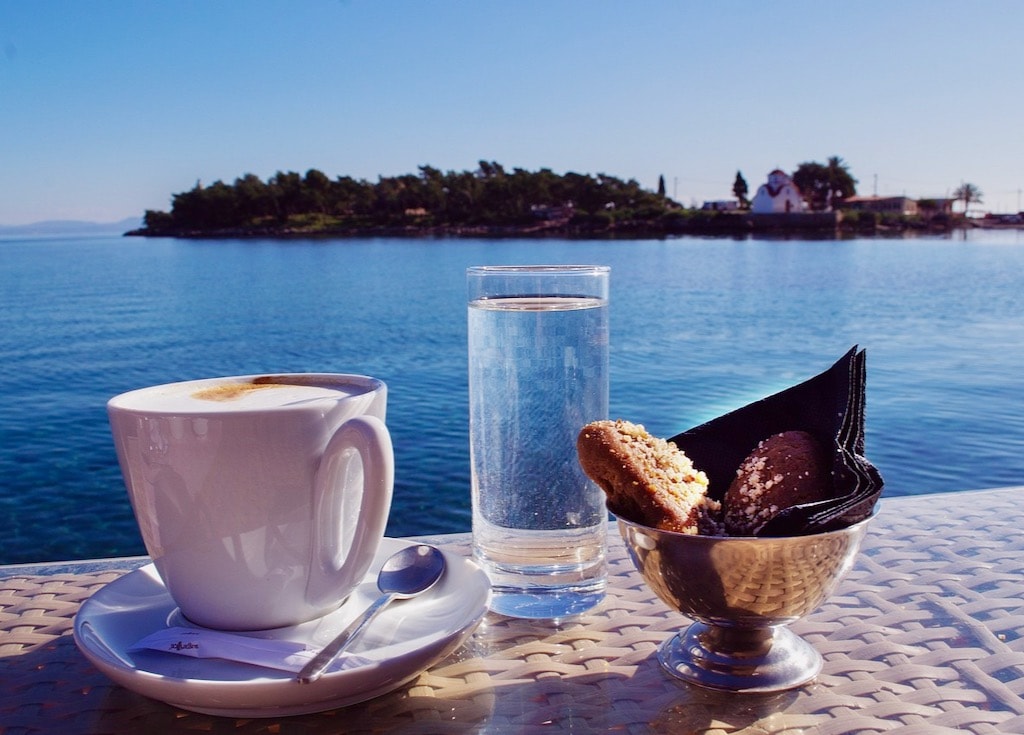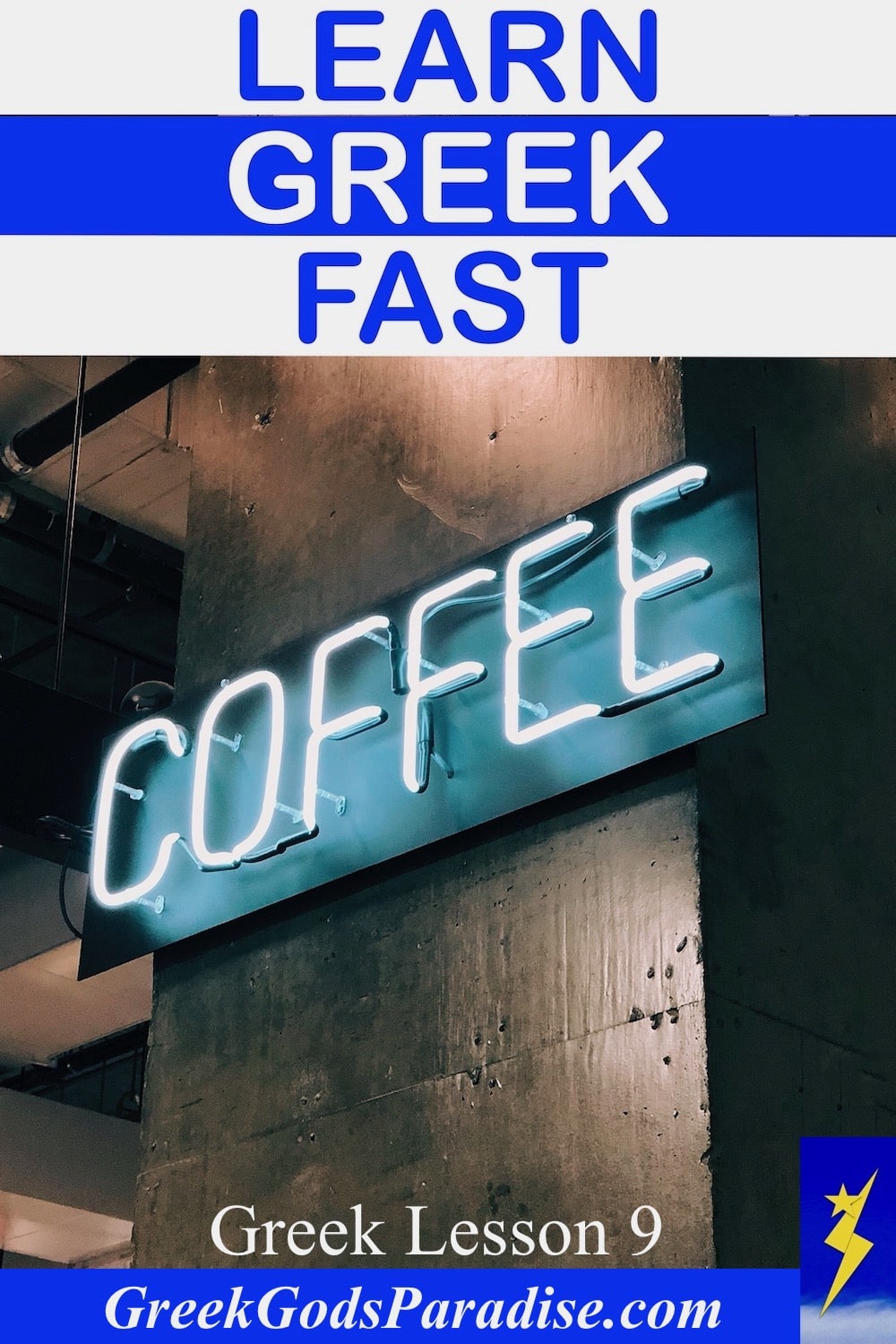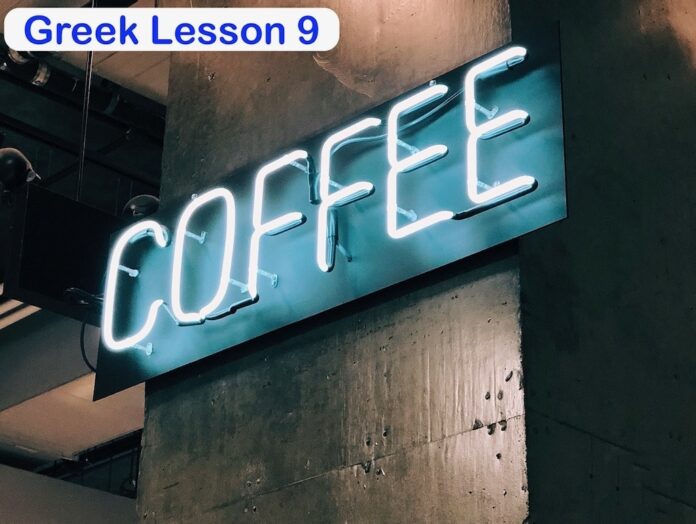In this Greek lesson, you will learn how to order coffee in Greece like a Greek local. Greek coffee culture and the way Greek people go about drinking coffee is also explained.
Four of the most popular coffees in Greece include:
- Greek coffee (hot traditional Greek coffee)
- Freddo espresso (cold espresso)
- Freddo cappuccino (cold cappuccino)
- Frappe (cold Nescafe instant coffee)
As you can see, three of the coffees in this list are cold coffees. Drinking cold coffee in Greece is very popular during the summer months and all year round with Greeks and tourists alike. However, if your preference is to drink a hot espresso or hot cappuccino, all you need to do is drop the “freddo” when giving your order, because freddo means cold in Greek.
In this Greek lesson just say the blue and red text as an English speaker would when trying to say the words. There is a red and blue version that is slightly different to help you pronounce the words correctly. Say the words out loud and you’ll be talking Greek in no time.
How to Order Coffee in Greece
The first section of this Greek coffee lesson will teach you how to order a coffee in Greece in a simple way.
After learning about the most basic ways to ask for a coffee, we will then proceed to learn how to order the four best coffees in Greece, the way a Greek local would. This will include:
- How to order Greek coffee in Greece.
- How to order a Freddo expresso in Greece.
- How to order a Freddo cappuccino in Greece.
- How to order a Frappe in Greece.
To begin with, here is a very simple way to ask for a coffee.
Note: If you ask for a coffee in this way, the person serving you will want know if you would like some milk and sugar in your coffee, but don’t worry about that for now.
A, coffee, please
E-nan, kaf-e, par-ra-kalo
En-nan, kaf-eh, par-ra-karl-or
Ena is the Greek word for one, so the above statement also means one coffee, please.
The reason you say enan, rather than ena, is because coffee is a masculine word in Greek. The Greek language is difficult to comprehend sometimes, so for now, just remember to say “enan” like a Greek person would when ordering one coffee.
Most Greeks would probably expand on it by saying:
I would like, a, coffee
Tha ithela, enan, kaf-e
Tha ith-el-a, e-nan, kaf-eh
Starting with “Tha ithela” is a very popular way to ask for something in Greek.
I want, a, coffee
Thel-o, enan, kaf-e
Thel-or, en-nan, kaf-eh
In Greece, this is another good way to order coffee. English speakers normally wouldn’t say “I want a coffee” to the person serving them, but saying Thelo Enan Kafe (followed by the sugar level Sketo/Glyko/Metrio) is very common among Greeks.
Saying either “Thelo” or “The ithela” as previously shown are definitely the two most common leading statements when ordering a coffee in Greece.
I questioned George on this to see if one way was better than the other as most website pages and YouTube videos discussing how to order Greek coffee in Greek normally always recommend saying ‘Tha Ithela” first when asking for a coffee. Saying “Thelo” was often mentioned straight after as an alternative way, so which one was better? I was also curious to know what percentage of people would say “Tha ithela” compared to “Thelo” in George’s opinion. George replied:
Both are correct. If I’m the first one to order (or if alone), I’d say, “Tha Ithela Enan Kafe.” However, if I want to be polite and let someone else order first, I’d say “Ego Thelo…”. It wouldn’t be wrong to say “Ego Tha Ithela,” but I’m just used to it. Maybe Tha Ithela is a tad more polite, but I doubt it. Maybe 60% Tha Ithela and 40% Thelo…
Note: “Ego” in Greek means “I” in English.
When ordering a coffee, you could also say the following statement, but it is much less common.
Can I have, a, coffee, please
Boro na ek-ho, enan, ka-fe, parakalo
Bor-ror na ek-hor, enan, kaf-eh, par-ra-karl-o
Obviously, if you do order a coffee in any of the above three ways, you will most likely receive some sort of follow-up question, because the person serving you will want to get your coffee order right. They will want to know how much sugar you want, and if you would like any milk in the coffee (if milk is optional).
So now, let’s learn about different sugar options in Greece so that Greek sugar preferences become familiar.
Sugar Options (4 common sugar requests)
For every coffee order you give, you should specify the amount of sugar you want.
Greeks typically request one of four sugar options:
- sketos (plain) – no sugar (and also no milk).
- me oligi (meh oh-lee-ghee) (a little bit) – half a teaspoon of sugar.
- metrios (medium/half-sweet) – generally means 1 teaspoon of sugar, but assume 1-2.
- glykos (sweet) – usually means 2 teaspoons of sugar, but you may get up to 3 teaspoons of sugar. In any case, you should get more sugar than coffee, put it that way.
When Greeks say the amount of sugar they want when ordering a coffee, you won’t hear the “s” sound, which you can see at the end of sketos, metrios, and glykos.
Instead, they say sketo, metrio, or glyko, after requesting the type of coffee they want.
Let us start by learning how to say the word, sketo (plain), meaning no sugar (and also no milk).
plain
sketo
ske-tor
Plain (black) – σκέτo
Black coffee containing no sugar and no milk is called σκέτο, meaning “plain.”
Sketo is unsweetened. To remind you of this fact, think of a skeleton (bare bones). The “ske” is pronounced like ske in skeleton, with an emphasis placed on SKE-tor.
If your preference is for a bold and bitter coffee, then “sketo” is probably the best choice for you to make. But don’t forget, with Greek coffee most people prefer at least a little bit of sugar to sweeten it enough so the bitterness disappears.
a little bit (of sugar)
meh olig-i
meh oh-lee-ghee
A little sugar means about half a teaspoon of sugar.
medium
met-ri-o
met-ree-or
Metrio (medium/half-sweet) (μέτριο) usually means you will get one teaspoon of sugar.
Metrios means equal amounts of coffee and sugar. So if you include metrio in your coffee order, you will most likely get one teaspoon of sugar for each teaspoon of ground coffee.
sweet
glyko
glee-kor
Glyko (sweet) (γλυκό) usually means 2 teaspoons of sugar.
But you may find you get 2-3 teaspoons of sugar. It depends on the person serving you. You will certainly get more sugar than coffee when you ask for you coffee to be sweet.
As a reminder, think of the English word glucose, which is a type of simple natural sugar. Yes, the English word was actually derived from the Greek word.
For Advanced Learners only: People write the words sketos, metrios, and glykos. The coffee/sugar related words are all over the Internet. I asked George in what situation Greeks would pronounce these words with the “s” sound. Why write it like this if Greeks don’t pronounce the “s” when ordering a coffee? There must be some situations where you or someone else will say these words with the “s” sound at the end.
George’s response: So…Here you will have to enter (once again) the twilight zone of the Greek language. Indeed, the words are used with “s” in the end. However, it’s all a matter of syntax. I’m not an expert, but I’ll do my best to give you some examples. “Mou Aresei O Sketos Kafes”. This means “I like Sketos coffee”. In this context, we use the nominative. The nominative in Greek masculine words ends 99% of the time with “s” in the end. That’s why you see Sketos, Metrios, Glykos. On the other hand, if you say “Tha Ithela Enan Metrio Kafe” you have to use accusative. The masculine word “Kafes” shows us that we need to add an “n” at “Ena” but you also drop the “s” from Metrios. So you have “Metrio.” In Ancient Greek (and also in 19th century Greek) the “n” would have been added to the “Metrio” too. So we would have “EnaN MetrioN Kafe.” Luckily, in modern Greek, it was simplified.
I also asked George, in what situation will I hear someone say Kafes with the “s” sound? George’s response: Again, it’s the nominative “o Kafes” and the accusative “Ton Kafe”. In the accusative, the “s” is dropped. For example, “Mou Aresi o Kafes” but “Thelo Enan Kafe.”
Here are some more useful sugar terms:
- one, teaspoon, of sugar – ena, kouta-larki tou gli-kou, zar-ha-ri
- very sweet (approx. 3 teaspoons of sugar) – poli-glyko / vari-glyko (either way)
- white sugar – za-hari
- brown sugar – mavri za-har-i (Believe it or not, Greeks always say “Mavri Za-hari,” which means Black Sugar. No one will say kastani za-hari, even though you will see it on the Internet.
- natural sweetener/sugar substitute – stevia (Greeks on a diet or just taking care of their silhouette, will skip even the Brown Sugar and ask for Stevia.)
Coffee cup sizes
large / medium / small
me-ga-lo / meh-say-or / mek-ror
meh-gah-lor / mes-ai-o / mekror
These are the Greek words for large, medium, and small.
- Large / large – Μεγάλο / μεγάλο
- Medium – Μεσαίο
- Small / small – Μικρό / μικρό
If you are getting a takeaway coffee, where different cup sizes are available, just say the desired cup size before making your coffee choice. For example: A large coffee, please – Enan me-ga-lo ka-fe, parakalo.
The Large, Medium, and Small cup sizes usually apply to coffee chains like Starbucks.
In Greece, unless they have special sizes clearly written, you won’t normally have this type of choice to make. Usually you go for Mono or Diplo.
The two main options for cup sizes in Greece are as follows:
- monos – single portion (You don’t have to say this because this is standard.)
- diplos – double portion (a big cup of coffee)
Note: Monos (single) or Diplos (double) are used only with espresso and cappuccino.
When you want to order an espresso or cappuccino, you can say “Tha Ithela Enan Diplo Espresso/Enan Mono Cappuccino.” If you don’t say it, the waiter will probably ask, “Mono I Diplo?”
Note: Freddo, Frappe and filter coffee are one size.
The Greek word for cup is Flitzani. Apart from Flitzani, you can also use the word Kupa (deriving from Cup). It’s a feminine word, therefore, it is “I Koupa.” That said, “Mia Koupa Kafe.”
double portion
diplo
dip-lor
Notice how the “s” is dropped. If you want a large cup of coffee, generally considered to be double the volume compared to a normal cup of coffee, then you add the word “diplo” to your coffee order. Further down is an example, which shows how to order a double Greek coffee.
Now let’s learn how to order certain coffees in Greece starting with Greek coffee. After that we will learn how to order the Freddo Espresso, the Freddo Cappuccino, followed by the Frappe.
1. How to order Greek coffee in Greece
The first coffee we will learn to order is a traditional Greek coffee. Greek coffee is known as Elliniko kafe (ελληνικό καφέ) or Elliniko kafes.
Greek coffee
Elliniko kaf-e
E-lee-nee-koh kaf-eh
Greek coffee was known as Turkish coffee in Greece, but the name changed to Greek coffee and stayed that way after the Turkish invasion of Cyprus in 1974.
When ordering a Greek coffee, there is no need to say “kafe” at the end after you have said Elliniko. You just need to say the word “Elliniko” at a cafe in Greece and that should be enough for the person serving you to understand that you want a Greek coffee.
Greek coffee, (medium), please
Elliniko, met-ree-o, parakalo
E-lee-nee-koh, met-ree-or, par-ra-karl-or
“Elliniko metrio parakalo” is an easy way to order an authentic Greek coffee in a kafeneio “καφενείο” or “καφενές” (a Greek cafe).
Greek coffee (Ellinikos kafe) is served in a smallish cup. The small cup is known as a demitasse (demi-tas) cup, which in French is a half cup. Most people think of these small cups as espresso cups, but the proper term is demitasse.
Traditional Greek coffee is made using a small brass or copper pot called a briki, where the Greek coffee is boiled inside. One of the benefits of the coffee being boiled is that is it extracts more nutrients from the coffee compared to the filtering method. It may be a surprise you, but Greek coffee only contains a moderate amount of caffeine, which is said to be much lower than many other blends. The hot drink is high in antioxidants and it tastes delicious. Just make sure you don’t drink the sandy-textured sediment at the bottom of the cup as it has a very bitter. taste
Sip your Greek coffee slowly and definitely don’t shoot it down like Italians do when drinking small cups of espresso coffee. Greek coffee requires slow sipping and you need to stop sipping when you reach close to the bottom, otherwise you will taste the bitter sediments.
Boiling the Greek coffee also creates a thick creamy foam on top of the Greek coffee called “kaimaki” (kai-mah-kee) that adds to the enjoyment of the coffee. Your coffee will most likely be perfect if the kaimaki is thick and the whole surface of the cup is covered in it. Greeks appreciate a nice amount of kamaiki on their Greek coffee.
Greek coffee is often served with spoon sweets, sweet cookies or a tiny piece of loukoumia, which many would consider to be Turkish delight. Buying a delicious pastry like a baklava, one of the best Greek pastries is also a great choice to make when enjoying your coffee.
Greek coffee is made with the sugar added during the boiling process. So you need to know how sweet you like your coffee prior to giving your order. You may have to try a few different Greek coffees with different sugar levels before you know which one you like best. Asking for metrio (medium) seems to be a safe bet for most people.
Greeks don’t normally drink Greek coffee with milk, but some of the younger people do prefer to have milk in it from what I have heard.
Don’t stir the Greek coffee and leave it still for a little while before taking your first sip, to give some time for the coffee grounds to settle to the bottom of the cup. By doing so, you will release even more of the coffee’s flavour.
I want, a, Greek coffee, double (half-sweet)
Thelo, enan, Eliniko, diplo, metrio, parakalor
Thel-or, enan, Eli-nik-or, dip-lor, met-ree-or, para-kalo
When you order a double Greek coffee, it will be twice the volume. So in this case you will get a double Greek coffee in a larger cup, as “diplo” means double portion.
Remember, ordering your coffee with “metrio” medium sugar level, will likely mean that you get an equal an amount of coffee with an equal amount of sugar in it. A normal Greek coffee normally has one teaspoon of coffee and one teaspoon of sugar.
A double coffee will likely contain two teaspoons of coffee and two teaspoons of sugar. Think of it like getting two small cups of Greek coffee inside a bigger cup.
Traditional Greek coffee is served in most coffee places around Greece. However, you may find that some of the modern venues compromise on quality by making the Greek coffee in an espresso machine. You can always ask how they make their Greek coffee. You should go somewhere else if they don’t make Greek coffee with a briki (pot with long handle).
Keep your eye out for establishments that make Greek coffee the traditional way. The best way is if they brew the Greek coffee on hot sand called havoli. Supposedly this brewing method produces the best Greek coffee.
2. How to order Freddo Espresso in Greece
Freddo Espresso is a cold espresso coffee.
The word “freddo” means cold in Greek, so a Freddo Espresso is a cold espresso.
I would like, a, cold, espresso, medium
Tha ithela, enan, fre-dor, espress-or, metrio
Tha ith-el-a, enan, fred-dor, espress-o, meh-tree-or
If you don’t want dairy in your coffee, then a Freddo Espresso is the coffee to get.
Freddo (cold) coffee is probably the most popular coffee to order in Greece these days. Cold coffee is even more popular than Greek coffee especially during summer, when younger Greeks and tourists much prefer to drink cold coffee.
The simplest coffee has to be the Freddo Espresso. This cold coffee is basically a hot Italian style espresso mixed with ice-cubes. Sugar is also added during the mixing process. The espresso, ice and sugar gets mixed together often with an electric mixer. By having contrasting hot and cold temperatures, it also assists in making the signature foam, which appears on top of the coffee. It looks somewhat like a foamy layer of milk, but the foam is just coffee. Freddo Espresso is also served with ice-cubes and a straw, similar to every other cold coffee.
Most Greeks order a “Freddo Espresso” by just saying “Freddo.” This should be enough for the barista to understand that you want a Freddo Espresso.
3. How to order Freddo Cappuccino in Greece
The Freddo Cappuccino is another a cold coffee. It is very popular coffee in Greece.
A Freddo Cappuccino is the same as a Freddo Espresso, but it also contains milk. This coffee is made with espresso and ice, and it is also comes with foamy layer of milk on top.
I would like, a, cold, cappuccino, medium
Tha ithela, enan, freddo, capouts-ino, metrio
Tha ith-el-a, enan, freddo, cap-oots-een-or, meh-tree-or
If you prefer some milk in your cold coffee, then a Freddo Cappuccino is an excellent cold coffee to order.
Some cacao or cinnamon may also likely be sprinkled on top of the coffee to make it tastier.
4. How to order a Frappe in Greece
Frappes are always cold and were the first cold coffees in Greece to take off in a huge way.
By the 1980s, the Frappe took over as the Greek capital’s number one coffee choice. However, these days the Frappe has been overtaken in popularity by the Freddo Espresso and Freddo Cappuccino.
The word frappe comes from the French verb “frapper” which means something like hit, strike, or shaken. Even though the name has French roots, the coffee is a Greek invention. A Greek from Thessaloniki in 1957 created the Frappe when he wanted to make an instant coffee but wasn’t able to access hot water. Instead, coffee was shaken with some cold water and sugar. That’s how the thick foam was created. Some ice-cubes were added, and that’s how the new legendary cold coffee in Greece was born.
Frappe
Fra-pe
Frar-peh
There are essentially four kinds of frappe (φραπέ):
- with milk.
- with a little milk.
- without milk.
This cold coffee is almost always made with Nescafe instant coffee. It can include 1, 2, or possibly up to three tablespoons of Nescafe instant coffee. It is made with Nescafe coffee, water, sugar, milk (optional) and ice cubes that are blended together with a hand mixer, or some other way, such as by shaking it inside a container.
When choosing a sugar sweetness level, you can order it “sketo” (no sugar), “metrio” (medium – equal amounts of sugar and coffee), or “glyko” (sweet).
Frappe, medium sweet, with milk
Fra-pe, metrio, meh gar-la
Frar-peh, met-tree-oh, meh ga-la
Your Frappe with milk will most likely be made using some evaporated milk as it is very common in Greece. However, whether it is evaporated milk or real milk is questionable. The milk foam can be created by putting some ice cubes in a glass and pouring enough evaporated milk over the ice cubes. A hand mixer or blender is then used to mix it up until it gets frothed into a thick creamy foam. Another way to mix it is by using a cocktail shaker.
When George reviewed this Greek lesson I found out that he is one Greek who doesn’t like Frappe, so his knowledge regarding Frappe might be limited. He agreed that evaporated milk is very common in Greece and stated that you can even “eat” it: it’s thick and super sweet and kids (of all ages:D ) love it. He wasn’t sure, but he thought in Frappe the Greeks use regular milk. Maybe I came across some sort of a local recipe where the Frappe uses evaporated milk. So for now, I can’t say for sure what type of milk is added to make a Frappe when requesting milk in it. Personally, I’m hoping it’s real milk.
Important Note: Make sure you leave a gap when saying “with milk” because meh gala sounds very similar to megalo, which means large in Greek. If someone confuses what you say, you could unintentionally find yourself receiving a large coffee.
Frappe, with a, little, milk
Fra-pe, kai, ligo, gala
Frar-peh, kay, lig-or, garl-a
If you would like a little bit of milk in your Frappe, you can order it as shown above.
If you just ask for a Frappe by specifying the sugar level only, you will probably get your Frappe without milk. But more likely, the person serving you will probably want to know if you would like milk in your Frappe.
The difference in the amount of milk you would get if you were ask for Frappe with milk, compared to asking for Frappe with a little milk, is anyone’s guess.
I want, one, frappe, with lots of, milk, and, medium sweet
Thel-o, enan, Fra-pe, meh poli , gala, kai, met-ree-or
Thel-lor, e-nan, Fra-peh, meh poly, garl-a, kay, met-ree-o
You could order a Frappe with lots of milk in your coffee in this way, but that would leave it open for the person serving you to decide how much milk to put in your Frappe, which could vary greatly from person to person.
When I questioned George about it, his guess was that it could be something like a double portion of milk.
I wanted to know how to order a Frappe with milk only and no water. So the above statement didn’t seem to be the best thing to say. Sure you would get more milk in your Frappe than a normal Frappe if you added “meh poli gala” to your order, but it wouldn’t guarantee a Frappe made with just milk.
In Cyprus, they seem to ask for an “all milk” Frappe by saying “Enan Frappe Olo Gala.” It’s probably similar to a Latte Macchiato.
Originally I used “Olo Gala” – all milk, as the key thing to say. However, it didn’t seem right to George. After backtracking, I discovered that Frappe “Olo Gala” (all milk) was mostly shown on web pages associated with the island of Cyprus. However, George has never heard of an “Olo Gala” version before.
George preferred to say “Enan Frappe Mono Gala” when you want only milk in your Frappe with no water. Mόno means only (pronounced morn-or).
He also mentioned that most people who order Frappe probably don’t want extra milk because Frappe is strong, and milk will probably make it less intense.
without, sugar
hor-ees, za-har-ee
horis, zar-hari
If you want milk in your Frappe, but don’t want any sugar, you can’t say “sketo” because that means no sugar and no milk. That’s when you can say without sugar.
Frappe, (sweet), without milk
Fra-pe, gliko, hor-ees, garla
Frar-peh, gli-kor, horis, gar-la
If you definitely don’t want milk in your Frappe, then you can say this.
More Coffee Order Requests
Espresso / Cappuccino (strong hard) – Espresso / Cappuccino var-e
Espresso / Cappuccino (with heavy cream) – Espresso / Cappuccino meh crem-a
Latte – Lart-eh (very similar to the English pronunciation)
Freddochino (cold chocolate/mocha milkshake) – Freddochino is a delicious non-caffeinated drink which is more of a sweet beverage. It is often topped with whipped cream, so you have to try it in Greece during a summer vacation.
Coffee decaf – Kafe dek-af-een-e
Tea – Tsai (Greeks don’ t often drink tea.)
Water – Ne-ror
Straw – Kal-a-markia
Takeaway – Younger Greeks will use the English term “Enan Kafe Ya Takeaway.” Alternatively, you can can say, “Enan Kafe Na Paro Mazi” (to take with me). Other people might -wrongly- say “Enan Kafe Paketo,” which means “in a packet” literally. This is probably influenced by the takeaway meals that are always in a packet. Pare Makrya won’t work in this context, although it’s technically correct.
Coffee Culture in Greece
Greeks go out for a coffee to enjoy long chats with friends and family. Coffee time is a social outing and it can go on for hours, with just one coffee order!
In Greece, a visit to a cafe can easily last from 90 minutes to three hours or even the whole day from what they say.
Cafes are everywhere in Greece and there are two different types you have to know about.
Modern Greek coffee shops are known as kafeteria. This type of cafe is what most people are familiar with. It serves a variety of coffees including the freddo espresso. The kafeteria is where you’ll find plenty of young people drinking coffee. Many of them will also be enjoying some sort of pastry with it.
The other type of coffee shop is the kafeneio, which serves traditional Greek coffee (ellinikos kafes). This is where you will see mostly local elderly men drinking their daily cup of Greek coffee. The kafeneion is where they discuss the latest news and politics. Some of the men may also be playing cards, or the board game backgammon. Tourists can also go and buy a traditional Greek coffee at a kafeneion. Females may feel uncomfortable going inside, but if you’re a guy, it is worth a visit for a taste test. It would also be a great opportunity to put this Greek lesson to the test!
Coffee in Greece: Tips and Etiquette
If you feel like having a coffee at the kafeteria, all you need to do is find yourself a table and sit down. Someone will generally come out to you and take your order, unless it is a place like Starbucks or Da Capo on Athens. Da Capo is one place in Athens where you still have to go to the counter to place your order.
Generally, a glass of water will be brought to your table with your coffee. A glass of water is included in the price of the coffee, so it is essentially free, and probably much appreciated, especially on a hot day.

Once you have your coffee, feel free to stay in your spot for as long as you like. In Greece, spending one to two hours at a cafe is not a problem and it’s very common among Greeks. You want to take it easy. There is a specific Greeks word ‘halara‘ that is a popular saying in Greece, especially in Thessaloniki. It literally means to take it easy. It stems from the laid back lifestyle and outlook Greece is known for. You might want to use it when speaking about yourself, or when giving advice to a friend to relax.
Greeks rarely order another coffee, or anything else after making their first order. They will generally ensure their coffee lasts for the entire time they are at the cafe. I suppose all they have to do is leave a small amount of coffee in their cup until they are about to leave.
Tip: You can make a frappe last for a couple of hours just by adding more cold water to it.
All of the different cold coffee versions (Frappe, Freddo Espresso, Freddo Capuccino) are served with a straw. You will need one because it is difficult to drink any of these coffees without one. You may want to bring your own reusable straw if you have environmental concerns. A straw is also required for stirring cold coffee. Stirring a cold coffee is ritual that Greeks have mastered.
One last thing, Greeks don’t often using the word “please” when ordering something to eat or drink. It’s probably the same with English speakers. You don’t really have to say please, but I guess it wouldn’t hurt.
Coffee talk in Greece
If you want to ask someone to go out for a coffee, then this is a common thing to say.
Let’s go for a, coffee
Pa-meh, ya, kaf-eh
Par-meh, ya, kaf-e
“Pame Ya Kafe” is the most common way to ask someone out for a coffee.
Other variations are:
“Thes Na Pioume Kafe?” (Would you like to drink a coffee?)
“Pote Tha Pioume Kafe?” (When will we drink coffee? —–> That’s when you know people well, meaning that you already had coffee together.)
“Ehis Chrono Ya Kafe?” (Do you have time for a coffee? —–> That’s when you meet someone spontaneously and you’d like to have a coffee straight to catch up.)
How is your coffee?
Pos in or kaf-es sou
Pos-inor kaf-es sou
good / great / excellent / perfect
karlos / ex-air-ret-ikos / ex-or-hors / tel-ee-os
karl-os / ex-e-retikos / exo-hos / teli-os
I originally had ex-air-ret-iki, but it was corrected to ex-air-ret-ikOS (masculine). Kafes is masculine.
average / okay
metrios / edarxi
meh-tree-os / ed-darxi
When you say something is average in quality, because Kafes is masculine, you say, “Metrios.” It is also used when you order a coffee with a bit of sugar.
to our health
stin-ee yee-a muss
stin-ee yee-a marss
Greeks will often say “To our health” just before taking their first sip of coffee.
thankyou
Ef-ha-reest-o
Ef-har-rist-or
Lastly, don’t forget to say thankyou at some point when receiving your delicious coffee.
Best Cafes for a Greek Coffee in Athens, Greece
If you want to try a Greek coffee in Athens, then these three cafes often come up as being the best places to visit.
- Mokka in central Athens next to the central market. Established in 1923, it is well known place to get a great Greek coffee. That’s because they make Greek coffee in the traditional using a briki (pot) that is filled with coffee and brewed on hot sand called havoli.
- Da Capo in Kolonaki is another good choice for a Greek coffee including other types of coffee. This historic cafe is a popular choice with politicians and business men. The only issue is that it is self service only. You can still sit down at a table, but you will need to go to the counter to order your coffee.
- O Glykis (The Sweet) is a cafe located on a cobblestone street in the Plaka district of Athens. It’s a traditional kafeneio that serves great Greek coffee.
In Greece, there are coffee chains like Coffee Island, Gregory’s, Everest, Mikel, and Coffee Lab. You may want to try one of these places as well.
I asked George if he could recommend any top places in Athens to get a coffee. His reply was: I usually drink coffee at home because in the cafes it’s too strong for me. But I always enjoy a cup at Taf The Art Foundation, Resto 21, and Foyer Espresso Bar. I tried to think of places in downtown Athens mainly.
Greek Coffee Lesson – Conclusion
The lesson on how to order a coffee in Greece like a Greek coffee is now complete.
Key Greek words/phrases/sentences taught in LESSON 9: 33
Greek lesson 9 has equipped you with the ability to order a coffee in Greece using the Greek language.
Now all you have to do is put it to the test in Greece by ordering a coffee using the Greek language.
Total number of key Greek words/phrases/sentences from all lessons so far: 248
Here are all of the Greek speaking lessons if you want to learn more.
Greek Teacher George
Special thanks to George for reviewing and improving Greek lesson 9: How to order coffee in Greece like Greek coffee.
 George runs the interesting travel blog Letters to Barbara.
George runs the interesting travel blog Letters to Barbara.
By the way, do you know what George’s favorite coffee is? If you don’t, you can find out by reading this fantastic interview with George Pavlopoulos.
Pin it … Share it






